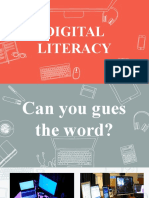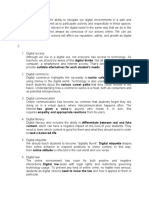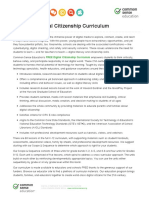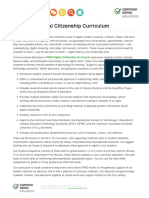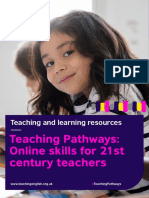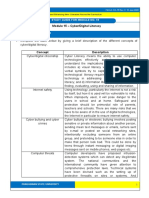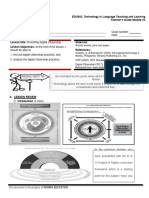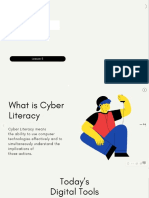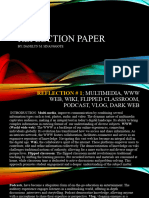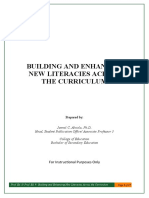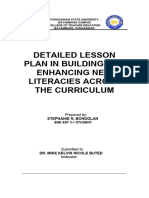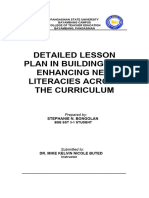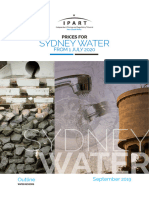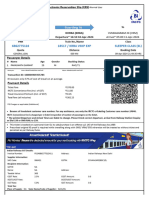Republic of the Philippines
ILOCOS SUR POLYTECHNIC STATE COLLEGE
www.ispsc.edu.ph | op@ispsc.edu.ph
Module 5: Digital Literacy
Welcome to Module 5!
Good day, class! I hope you are doing well. This week, we begin our deep dive into
the specific "new literacies" that are essential for the 21st century. We will start with one of
the most foundational: Digital Literacy.
In this module, we will move beyond simply "using computers" to understand what it
truly means to navigate the digital world effectively, ethically, and safely. As future
educators, mastering these skills is non-negotiable, both for our own professional lives and
for modeling responsible digital citizenship for our students.
All materials and submission links for this module are in our Google Classroom. Our
Messenger Group Chat is always open for quick questions and clarifications. Let's begin!
Intended Learning Outcomes (ILOs)
By the end of this module, I expect you to be able to:
● Define digital literacy and articulate its significance for educators and learners.
● Navigate various online platforms, educational tools, and digital resources effectively.
● Evaluate the credibility of online information and identify misinformation and
disinformation.
● Create and share digital content responsibly, adhering to copyright laws and ethical
practices.
● Integrate digital tools into lesson planning and instruction to enhance student
engagement and learning.
● Model safe and responsible online behavior for your future students.
Our Weekly Checklist & Deadlines
To succeed in this module, please complete the following tasks by their deadlines:
● By Wednesday, July 1, 2025:
○ Carefully read the Part 1: Core Learning Content & Lecture Notes I have prepared
for you.
○ Complete the Part 2.1: Digital Literacy Self-Assessment in your personal notebook.
○ Complete the Part 2.2: Online Scavenger Hunt activity.
○ Post your initial response and your scavenger hunt findings to the "Module 5
Discussion Question" on Google Classroom.
● By Sunday, July 2, 2025
○ [ ] Complete the "Module 5 Quiz" .
○ [ ] Submit your major assessment from Part 3 to the "Digital Citizenship Instructional
Package Assignment" on Google Classroom.
Educ 102: Building and Enhancing New Literacies Across Curriculum Page 1 of 6
Prepare by: Severo B. Talipo
� Republic of the Philippines
ILOCOS SUR POLYTECHNIC STATE COLLEGE
www.ispsc.edu.ph | op@ispsc.edu.ph
Part 1: Core Learning Content & Lecture Notes
Instructions: In this section, I have prepared the core content for our module. It is essential
that you read this material carefully and thoroughly, as all our activities and assessments
are based on it.
Foundations of Digital Literacy
Digital literacy is broadly defined as the ability to find, evaluate, utilize, share, and
create content using digital technologies and the internet (American Library Association,
2013). It is not just a technical skill; it is a form of literacy that encompasses a wide range of
cognitive and social competencies. For our students, it is the literacy of their generation
and the primary way many of them will learn, work, and participate in society.
Our exploration will cover three key areas:
1. Navigating the Digital Landscape: How to find and evaluate information.
2. Creating and Sharing Digital Content: How to be a responsible creator.
3. Digital Safety and Security: How to protect ourselves and our students.
1. Navigating the Digital Landscape: Finding and Evaluating Information
The internet has democratized access to information, but it has also created a tsunami of
misinformation and disinformation. The ability to navigate this landscape is perhaps the
most critical component of digital literacy.
a. Effective Searching: This goes beyond typing a query into Google. We should teach
students strategies like:
1) Using quotation marks to search for an "exact phrase."
2) Using a minus sign to -exclude a specific word.
3) Using site:.gov or site:.edu to limit searches to government or educational
institutions.
b. Evaluating Credibility: How do we know if a source is trustworthy? A popular and
effective method is the SIFT method developed by digital literacy expert Mike Caulfield
(2019):
1) (S)top: Before you read or share, pause. Ask yourself if you know the website or
source. If not, don't read it yet.
2) (I)nvestigate the Source: Leave the article you're on and do a new search to find
out more about the publication or author. Who are they? What is their expertise?
What do other sources say about them?
3) (F)ind Better Coverage: Look for trusted, expert reporting or analysis on the same
topic. See if multiple credible sources are reporting the same thing. This is often
called "lateral reading."
4) (T)race Claims, Quotes, and Media to the Original Context: A lot of misinformation
Educ 102: Building and Enhancing New Literacies Across Curriculum Page 2 of 6
Prepare by: Severo B. Talipo
� Republic of the Philippines
ILOCOS SUR POLYTECHNIC STATE COLLEGE
www.ispsc.edu.ph | op@ispsc.edu.ph
happens when a quote or video is taken out of its original context. Trace it back to
the original source to see the full picture.
2. Creating and Sharing Digital Content: Rights and Responsibilities
Every time we post a photo, write a blog, or create a video, we are digital creators. We
must teach our students to do this responsibly.
a. Copyright and Fair Use:
1) Copyright is a law that gives the owner of a creative work (like a photo, song, or
article) the exclusive right to use and distribute it. You cannot simply take any image
from Google and use it in your project.
2) Fair Use is a principle that allows for the limited use of copyrighted material without
permission for purposes like criticism, commentary, news reporting, and education.
However, "educational use" is not a free pass. It's a complex balancing act that
requires careful consideration (Stanford University Libraries, n.d.).
b. Creative Commons (CC): This is a non-profit organization that provides free, easy-to-
use copyright licenses to make it simple for creators to share their work. When you see
a CC license, it tells you exactly how you can use a work (e.g., you might need to give
credit to the author, or you may not be allowed to use it for commercial purposes).
Teaching students to search for and use CC-licensed materials is the best way to ensure
they are creating content ethically (Creative Commons, n.d.).
3. Digital Safety and Security: Protecting Ourselves Online
This is our fundamental responsibility as educators. We must create a culture of safety.
a. Digital Footprint: Every action we take online—a post, a comment, a 'like'—leaves a
trail. This is our digital footprint. We need to teach students that this footprint is often
public and permanent, and can have real-world consequences (ISTE, 2021).
b. Privacy and Personal Information: Students must learn never to share sensitive personal
information online (full name, address, phone number, school name). They should also
learn how to use privacy settings on social media to control who sees their content.
c. Passwords and Security: Teach the importance of creating strong, unique passwords
and not sharing them with anyone.
d. Cyberbullying and Online Etiquette: This involves teaching digital citizenship—the norms
of appropriate, responsible behavior online. This means treating others with respect, not
engaging in hate speech, and knowing what to do if they or someone they know is
being cyberbullied (e.g., don't engage, block the person, tell a trusted adult).
Part 2: Interact & Apply
2.1 Digital Literacy Self-Assessment
Instructions: In your personal notebook, create three columns titled: "I am Confident," "I
am Okay," and "I Need to Learn More." Based on the lecture notes you just read, place
Educ 102: Building and Enhancing New Literacies Across Curriculum Page 3 of 6
Prepare by: Severo B. Talipo
� Republic of the Philippines
ILOCOS SUR POLYTECHNIC STATE COLLEGE
www.ispsc.edu.ph | op@ispsc.edu.ph
each of the following digital literacy skills into the column that best describes your
current ability. This is a private reflection for your own benefit.
○ Skills List: Creating strong passwords, Evaluating news sources for bias,
Understanding Creative Commons licenses, Using privacy settings on social media,
Teaching others about cyberbullying, Using advanced search techniques on
Google.
2.2 Offline Activity: Online Scavenger Hunt
Task: To practice your information evaluation skills using the SIFT method.
Instructions:
1. Choose one of the following controversial topics:
■ "The health benefits of intermittent fasting"
■ "The effectiveness of the new 'Matatag' curriculum in the Philippines"
2. Using an online search engine, your task is to find two different online articles about
your chosen topic:
■ One article that you believe is credible and trustworthy.
■ One article that you believe is less credible, biased, or potentially
misinformation.
3. On a piece of paper, for each article, briefly write down your analysis based on the
SIFT method.
■ S (Stop): Did you know the source?
■ I (Investigate): What did you find out about the author or publication?
■ F (Find other coverage): Did other credible sources say the same thing?
■ T (Trace claims): Were there any claims you could trace back to an original
study or report?
4. Take a clear photo of your SIFT analysis. You will upload this in our Google Classroom.
In the section for your answer, you must do two things:
■ Attach the photo of your completed SIFT analysis.
■ Write your answer to the following prompt (minimum 150 words):Prompt: In your
post, please share the links to both the credible and the less-credible articles
you found. What was the single biggest "red flag" that made you question the
less-credible source? Why is teaching the SIFT method (or a similar evaluation
strategy) essential for Filipino students today?
Part 3: Apply & Create (Major Assessment Task)
Major Assessment: The Digital Citizenship Instructional Package
Description: Your task is to create a small "instructional package" that you could use to
teach a digital citizenship topic to a specific grade level. This package will have two
parts.
Educ 102: Building and Enhancing New Literacies Across Curriculum Page 4 of 6
Prepare by: Severo B. Talipo
� Republic of the Philippines
ILOCOS SUR POLYTECHNIC STATE COLLEGE
www.ispsc.edu.ph | op@ispsc.edu.ph
Instructions:
1. Choose a Grade Level (e.g., Grade 4, Grade 9).
2. Choose one specific topic from our "Digital Safety and Security" notes (e.g.,
Creating Strong Passwords, Understanding Your Digital Footprint, What is
Cyberbullying?, etc.).
3. Create your package:
■ Part A: Short Instructional Video: Create a short (1-3 minute) video explaining
your chosen topic in a way that is engaging for your chosen grade level. You
can use simple tools like your phone's camera, screen recording software, or an
animation app like Canva or Powtoon.
■ Part B: Supporting Document: Create a single-page document (Word or Google
Doc) that contains:
■ A mini-lesson plan explaining how you would use this video in a classroom
activity.
■ A short Classroom Policy (3-5 rules) related to your topic that students would
be expected to follow.
Submission:
○ Upload your video file (MP4) and your one-page supporting document (PDF) to the
"Digital Citizenship Instructional Package Assignment" on Google Classroom.
Part 4: Reflect & Finalize (Wrap-up)
4.1 Module 5 Quiz
● Instructions: To check your understanding of Digital Literacy, please complete the short
quiz.
Need Help?
● For quick questions or clarifications, please send me a message in our Messenger Group
Chat.
● For more detailed questions about your assignments, please use the "Private
Comments" feature on the specific assignment in Google Classroom so I can assist you
directly.
References
American Library Association. (2013). Digital literacy, libraries, and public policy. Office for
Information Technology Policy. https://www.ala.org/offices/sites/ala.org.offices/
files/content/oitp/publications/policybriefs/digital_literacy.pdf
Educ 102: Building and Enhancing New Literacies Across Curriculum Page 5 of 6
Prepare by: Severo B. Talipo
� Republic of the Philippines
ILOCOS SUR POLYTECHNIC STATE COLLEGE
www.ispsc.edu.ph | op@ispsc.edu.ph
Caulfield, M. (2019, June 19). SIFT (The four moves). Hapgood.
https://hapgood.us/2019/06/19/sift-the-four-moves/
Creative Commons. (n.d.). About the licenses. https://creativecommons.org/
about/cclicenses/
International Society for Technology in Education. (2021). Digital citizenship. ISTE.
https://www.iste.org/standards/digital-citizenship
Stanford University Libraries. (n.d.). Measuring fair use: The four factors.
https://fairuse.stanford.edu/overview/fair-use/four-factors/
Educ 102: Building and Enhancing New Literacies Across Curriculum Page 6 of 6
Prepare by: Severo B. Talipo
